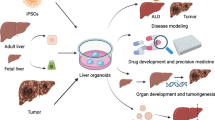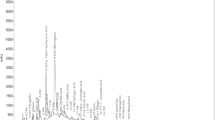Abstract
A new pancreas cancer cell line, SUIT-58, was established from metastatic liver tumor. The cultured cells exhibited polygonal shape, and proliferated in a form of sheet-structure showing prominent nucleoli and frequent mitotic features. Chromosome count ranged from 54 to 73 with modal chromosome numbers 72 and 73. It was noteworthy that this cell line grew in the serum-free media and maintained in this condition for 30 passages (designated as S58-SF). Both SUIT-58 and S58-SF cell lines were successfully transplanted into nude mice, and their tumor doubling times in xenografts were calculated as 5.4 and 2.8 days, respectively. Histopathologically, the xenografts formed glandular structure that resembled the original tumor. In culture media, the doubling time of SUIT-58 and S58-SF cell lines was calculated as 32 and 35.7 h, respectively. Although the cellular arrangements of SUIT-58 and S58-SF cell lines are different to some extent, their subcellular structures under electron microscope were similar with a large number of lysosomes and distinct desmosomes at cell-cell adhesion sites. The present SUIT-58 and its derivative cell line S58-SF will be applicable for biological studies to develop a new clinical treatment of refractory pancreatic cancer.






Similar content being viewed by others
References
Hruban RH. Pancreatic cancer. In: Stewart BW, Wild CP, editors. World Cancer Report 2014. France: International Agency for Research on Cancer; 2014. p. 413–21.
Iwamura T, Katsuki T, Ide K. Establishment and characterization of a human pancreatic cancer cell line (SUIT-2) producing carcinoembryonic antigen and carbohydrate antigen 19-9. Japanese J Cancer Res Gann. 1987;78(1):54–62.
Tsukuma H, Ajiki W, Ioka A, Oshima A. Research Group of Population-Based Cancer Registries of J. Survival of cancer patients diagnosed between 1993 and 1996: a collaborative study of population-based cancer registries in Japan. Jpn J Clin Oncol. 2006;36(9):602–7. doi:10.1093/jjco/hyl068.
Willett CG, Czito BG, Bendell JC, Ryan DP. Locally advanced pancreatic cancer. J Clin Oncol Offi J Am Soc Clin Oncol. 2005;23(20):4538–44. doi:10.1200/JCO.2005.23.911.
Fernandez-del Castillo C, Rattner DW, Warshaw AL. Further experience with laparoscopy and peritoneal cytology in the staging of pancreatic cancer. Br J Surg. 1995;82(8):1127–9.
Hoffman JP, Willett CG, Cohen SJ. Pancreas cancer: clinical management. In: Kelsen DP, Daly JM, Kern SE, Levin B, Tepper JE, Cutsem EV, editors. Principles and practice of gastrointestinal oncology. 2nd ed. USA: Lippincott Williams & Wilkins; 2008. p. 377–92.
Takahashi N, Aoyama F, Hiyoshi M, Kataoka H, Sawaguchi A. Establishment and biological characterization of a novel cell line derived from hepatoid adenocarcinoma originated at the ampulla of Vater. Int J Oncol. 2014;44(4):1139–45. doi:10.3892/ijo.2014.2282.
Sawaguchi A, Aoyama F, Ide S, Suganuma T. Capsule-supporting ring: a new device for resin embedding of glass-mounted specimens. J Microsc. 2009;234(2):113–7. doi:10.1111/j.1365-2818.2009.03161.x.
Kawano K, Iwamura T, Yamanari H, Seo Y, Suganuma T, Chijiiwa K. Establishment and characterization of a novel human pancreatic cancer cell line (SUIT-4) metastasizing to lymph nodes and lungs in nude mice. Oncology. 2004;66(6):458–67. doi:10.1159/000079500.
Kong D, Nishino N, Shibusawa M, Kusano M. Establishment and characterization of human pancreatic adenocarcinoma cell line in tissue culture and the nude mouse. Tissue Cell. 2007;39(4):217–23. doi:10.1016/j.tice.2007.04.001.
Frena A. SPan-1 and exocrine pancreatic carcinoma. The clinical role of a new tumor marker. Int J Biol. 2001;16(3):189–97.
Moore PS, Sipos B, Orlandini S, Sorio C, Real FX, Lemoine NR, et al. Genetic profile of 22 pancreatic carcinoma cell lines. Analysis of K-ras, p53, p16 and DPC4/Smad4. Virchows Arch. 2001;439(6):798–802.
Yamaguchi N, Yamamura Y, Koyama K, Ohtsuji E, Imanishi J, Ashihara T. Characterization of new human pancreatic cancer cell lines which propagate in a protein-free chemically defined medium. Cancer Res. 1990;50(21):7008–14.
Taniguchi S, Iwamura T, Kitamura N, Yamanari H, Kojima A, Hidaka K, et al. Protein-free culture of the human pancreatic cancer cell line, SUIT-2. Hum Cell. 1994;7(4):207–14.
Murphy LO, Abdel-Wahab YH, Wang QJ, Knezetic JA, Permnert J, Larsson J, et al. Receptors and ligands for autocrine growth pathways are up-regulated when pancreatic cancer cells are adapted to serum-free culture. Pancreas. 2001;22(3):293–8.
Sato N, Mizumoto K, Beppu K, Maehara N, Kusumoto M, Nabae T, et al. Establishment of a new human pancreatic cancer cell line, NOR-P1, with high angiogenic activity and metastatic potential. Cancer Lett. 2000;155(2):153–61.
Tan MH, Nowak NJ, Loor R, Ochi H, Sandberg AA, Lopez C, et al. Characterization of a new primary human pancreatic tumor line. Cancer Invest. 1986;4(1):15–23.
Chen WH, Horoszewicz JS, Leong SS, Shimano T, Penetrante R, Sanders WH, et al. Human pancreatic adenocarcinoma: in vitro and in vivo morphology of a new tumor line established from ascites. In Vitro. 1982;18(1):24–34.
Ghadially FN. Cell junctions. Ultrastructural pathology of the cell and matrix. 4th ed. MA: Butterworth-Heinemann; 1997. p. 1171–205.
Martinez-Palomo A. Ultrastructural modifications of intercellular junctions in some epithelial tumors. Lab Invest J Tech Methods Pathol. 1970;22(6):605–14.
Colombo F, Trombetta E, Cetrangolo P, Maggioni M, Razini P, De Santis F, et al. Giant lysosomes as a chemotherapy resistance mechanism in hepatocellular carcinoma cells. PLoS One. 2014;9(12):e114787. doi:10.1371/journal.pone.0114787.
Wang F, Weaver VM, Petersen OW, Larabell CA, Dedhar S, Briand P, et al. Reciprocal interactions between beta1-integrin and epidermal growth factor receptor in three-dimensional basement membrane breast cultures: a different perspective in epithelial biology. Proc Natl Acad Sci USA. 1998;95(25):14821–6.
Weigelt B, Ghajar CM, Bissell MJ. The need for complex 3D culture models to unravel novel pathways and identify accurate biomarkers in breast cancer. Adv Drug Deliv Rev. 2014;69–70:42–51. doi:10.1016/j.addr.2014.01.001.
Acknowledgments
We thank Drs. Hiroaki Kataoka and Kenji Yorita (The Section of Oncopathology and Regenerative Biology, Department of Pathology, Faculty of Medicine, University of Miyazaki) for their expertise on pathological diagnosis, Mr. Yoshiteru Goto (Division of Bio-Imaging Laboratory in Frontier Science Research Center, University of Miyazaki) and Ms. Yasuyo Todaka (Department of Anatomy, Ultrastructural Cell Biology, Faculty of Medicine, University of Miyazaki) for their expert assistances. This study was supported by Grants-in-Aids for Scientific Research from the Japan Society for the Promotion of Science (No. 23791552).
Conflict of interest
The authors declare that they have no conflict of interest.
Author information
Authors and Affiliations
Corresponding author
Rights and permissions
About this article
Cite this article
Takahashi, N., Aoyama, F., Ohuchida, J. et al. Establishment and characterization of SUIT-58 pancreas cancer cell line and its subline S58-SF adapted to serum-free condition derived from metastatic liver tumor. Human Cell 28, 190–198 (2015). https://doi.org/10.1007/s13577-015-0122-6
Received:
Accepted:
Published:
Issue Date:
DOI: https://doi.org/10.1007/s13577-015-0122-6




